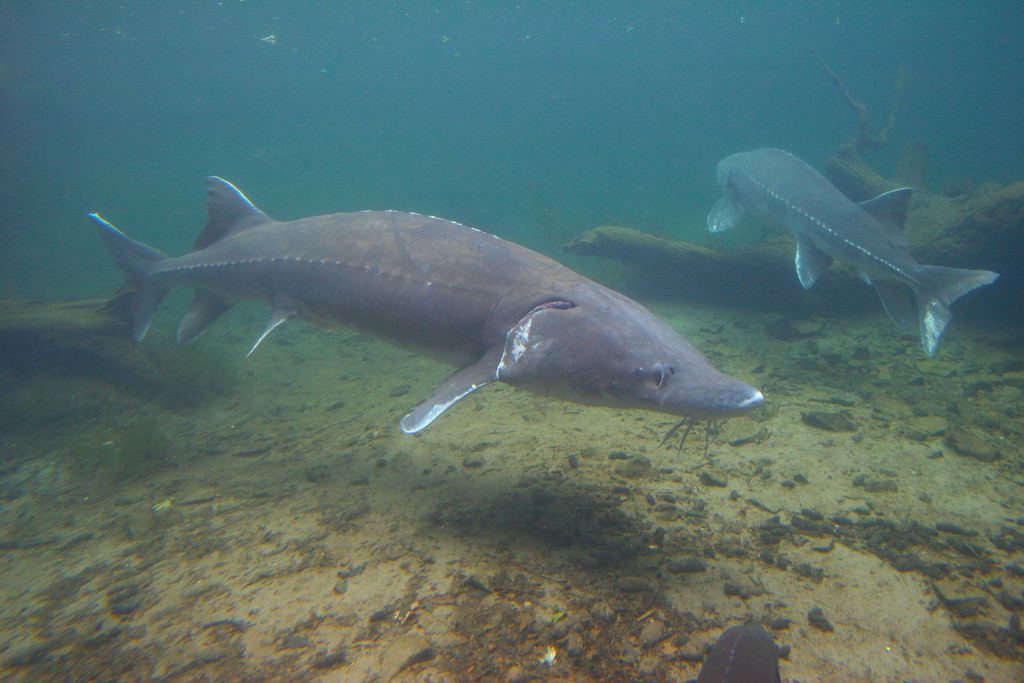Caviar. You may think it’s just tiny fish babies, but that’s like saying perfume is just aged whale vomit. Technically, it’s true (for real — check out ambergris, a prized ingredient in perfume here), but those tiny fish babies are so much more. I had the pleasure of attending a seminar on the expensive stuff at The Broadmoor’s Taste & Savor event and now I’m as close as you can come to being a caviar expert… without being anywhere close to being an expert in any respect.
What is Caviar?
So… what is caviar? It’s the eggs of a sturgeon. Great. What’s a sturgeon? It’s a fish. A massive fish. A nasty-looking prehistoric fish that grows into a giant fish monster that can weigh thousands of pounds. Just look at that beast. Yikes!
Photo: ![]()
![]() Some rights reserved by candescent
Some rights reserved by candescent
Inside that aquatic behemoth are eggs and those eggs are caviar. Of the 24 species of sturgeon out there, three are the most famous: beluga, osetra, and sevruga. They’re so good, in fact, that humans went ahead and ate all of them. There are basically no wild sturgeon left in the Caspian Sea, where most of the world’s caviar used to come from. Instead, sturgeon are now being farmed all over the world from California to China. Other types of roe (lumpfish, paddlefish, salmon) are sold with the c-word attached (no, not that c-word), but the only authentic stuff is from sturgeon.
Petrossian, one of the oldest names in the business and purveyors of the first major caviar restaurant in a US airport, was formed in 1920 and they remain one of the leading producers of caviar in the world. When they buy sturgeon roe (aka eggs), they clean the product and then salt them lightly. This curing process is what leads to caviar. Over time, the eggs mature and develop that briny flavor that caviar is known for. After months and months of aging in refrigerated tins (known in the industry as “original tins” or “OTs”), they’re ready to be served to you, the caviar loving consumer.
How to Serve Caviar
The first step to serving caviar is keeping it extremely cold and keeping it away from air. As Gwen Baird of Petrossian says, “air and heat are the enemies of caviar.” Store it in the coldest part of your refrigerator and try to consume it as soon as you open it.
The next component of proper caviar service involves the spoon. Traditionally, a mother-of-pearl spoon is used, but any non-metallic spoon is fine, including plastic. If you use a metal spoon of any sort, it’ll react with the caviar and that delicate flavor you paid so dearly for will be gone.
Crackers are a decent partner for those tasty little eggs, but the old school Russian way of serving caviar involves blinis, which are tiny buckwheat pancakes. Just take a small dollop, pop it on a blini and you’re good to go. No matter what you serve it on, though, make sure it doesn’t overwhelm the flavor. Some people like chopped egg and horseradish, but caviar deserves to be enjoyed on its own. If you want to pair it with a drink, a neutral vodka is certainly a great way to go.
Choosing Your Caviar
Let’s face it. Caviar is expensive. The question really becomes how expensive do you want your caviar to be? High-end caviar purveyors like Petrossian use a grading scale that takes into account size, color, texture, and flavor. The best stuff obviously costs the most, but you don’t always need to buy the highest quality. Unless you’re a caviar expert, it’s totally acceptable to spend your money on a slightly lower grade because you may not be able to tell the difference anyway.
If you’re looking to get into caviar, check out Amazon’s American sturgeon caviar selection or just look at this caviar sampler pack
that will give you a basic introduction to that fancy food that Tom Hanks spit out in the movie Big. Then put on your fanciest white tuxedo and get ready to wow your co-workers at the annual company party.




Man, I love that c-word.
I appreciate the informative, original content. Now I can pretend like I know what I’m doing when I have it on a plane.
Thanks, Alex.
Is there no credit card that comes with free caviar sign up???